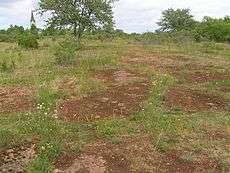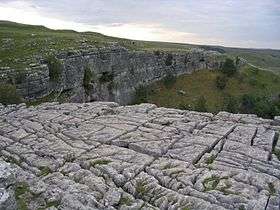Alvar
An alvar is a biological environment based on a limestone plain with thin or no soil and, as a result, sparse grassland vegetation. Often flooded in the spring, and affected by drought in midsummer, alvar support a distinctive group of prairie-like plants.[1] Most alvars occur either in northern Europe[2] or around the Great Lakes in North America.[3] This stressed habitat supports a community of rare plants and animals, including species more commonly found on prairie grasslands. Lichen and mosses are common species. Trees and bushes are absent or severely stunted.

The primary cause of alvars is the shallow exposed bedrock. Flooding and drought, as noted, add to the stress of the site and prevent many species from growing.[1] Disturbance may also play a role. In Europe, grazing is frequent, while in North America, there is some evidence that fire may also prevent encroachment by forest.[4] The habitat also has strong competition gradients, with better competitors occupying the deeper soil and excluding other species to less productive locations.[5] Crevices in the limestone provide a distinctive habitat which is somewhat protected from grazing, and which may provide habitat for unusual ferns such as Pellaea atropurpurea. Bare rock flats provide areas with extremely low competition that serve as refugia for weak competitors such as Minuartia michauxii and Micranthes virginiensis. In a representative set of four Ontario alvars, seven habitat types were described. From deep to shallow soil these were: tall grassy meadows, tall forb-rich meadows, low grassy meadows, low forb-rich meadows, dry grassland, rock margin grassland and bare rock flats.[6]
Alvars comprise a small percentage of the Earth's ecosystems by land extent. Although some 120 exist in the Great Lakes region, in total there are only about 112 square kilometres (43 sq mi) left across the entire Great Lakes basin, and many of these have been degraded by agriculture and other human uses. More than half of all remaining alvars occur in Ontario. There are smaller areas in New York, Michigan, Ohio, Wisconsin and Quebec.[7]
In North America, alvars provide habitat for birds such as bobolinks, eastern meadowlarks, upland sandpipers, eastern towhees, brown thrashers and loggerhead shrikes whose habitat is declining elsewhere. Rare plants include Kalm's lobelia (Lobelia kalmii), Pringle's aster, juniper sedge (Carex juniperorum), lakeside daisy (Hymenoxys acaulis), ram's-head lady's-slipper (Cypripedium arietinum) and dwarf lake iris (Iris lacustris). Also associated with alvars are rare butterflies and snails.[8] The use of the word "alvar" to refer to this type of environment originated in Sweden.[9] The largest alvar in Europe is located on the Swedish island of Öland. Here the thin soil mantle is only 0.5 to 2.0 centimeters thick in most places and in many extents consists of exposed limestone slabs.[10][11] The landscape there has been designated a UNESCO World Heritage Site. There are other more local names for similar landforms, such as a pavement barren, although this term is also used for similar landforms based on sandstone.[12] In the United Kingdom the exposed landform is called a limestone pavement and thinly covered limestone is known as calcareous grassland.
European alvar locations
- Sweden
- Öland – Stora Alvaret – largest alvar extent in Europe
- Gotland
- Västergötland – several locations on limestone mountain Kinnekulle, smaller fragments on Falbygden, e.g. in Dala and Högstena parishes
- Estonia
- Alvars are distributed along the whole northern coast of Estonia from approx. the town of Paldiski to Sillamäe, wherever limestone comes to the surface near the seashore (see Baltic Klint), as well as on the islands of the West Estonian archipelago. Estonia used to be home to approximately one third of the world's alvars; however, the total area of alvars has decreased from 43,000 hectares in the 1930s to 12,000 hectares in 2000, and approximately 9,000 hectares in 2010.[13] Estonian alvars are home to 267 species of vascular plants, approximately one fifth of which are protected. There are also 142 species of bryophytes and 263 species of lichens.[13] The Estonian government has committed itself to protect at least 9,800 hectares of the country's alvars as part of the Natura 2000 network.[14] The Loopealse subdistrict of Tallinn is named after alvar.
- Vardi Nature Reserve in Rapla County is an Estonian nature reserve especially designated to protect one of the more representative alvar areas of Estonia.
- England
- Ireland
- The Burren, a large alvar in northwest County Clare
 Sarve alvar in Hiiumaa island
Sarve alvar in Hiiumaa island Alvar in Väike-Pakri island
Alvar in Väike-Pakri island Sparse vegetation, Kinnekulle, Sweden
Sparse vegetation, Kinnekulle, Sweden Limestone pavement at Malham Cove, UK
Limestone pavement at Malham Cove, UK
Some North American alvar locations
- The rare Charitable Research Reserve – Cambridge, Ontario[15]
- Lake Erie
- Kelley's Island, Ohio – North Shore Alvar State Nature Preserve[16]
- Marblehead, Ohio – mostly destroyed by limestone quarrying
- Pelee Island, Ontario – Stone Road Alvar Nature Reserve[17]
- Lake Huron
- Maxton Plains Proposed Natural Area, Drummond Island, Michigan[18]
- Belanger Bay Alvar, Manitoulin Island, Ontario[19]
- Quarry Bay Nature Reserve, Manitoulin Island, Ontario[20]
- Bruce Alvar Nature Reserve, Bruce Peninsula, Ontario[21]
- Baptise Harbour Nature Reserve, Bruce Peninsula, Ontario[22]
- Misery Bay Provincial Park, Manitoulin Island, Ontario[23]
- Lake Michigan
- Red Banks Alvar, Red Banks, Brown County, Wisconsin[24]
- Lake Ontario
- Carden Plain Alvar, City of Kawartha Lakes, Ontario, including Carden Alvar Provincial Park[25]
- Chaumont Barrens Preserve, New York[26]
- Three Mile Creek Barrens, New York
- Burnt Lands Alvar, Almonte, Ontario
- Balsam Lake Indian Point Provincial Park, Ontario[27]
- Quebec
- Manitoba
See also
- Calcareous grassland
- Chalk heath
- Edaphic
- Gypcrust – A hardened layer of soil with a high percentage of gypsum
- Gypsum flora of Nova Scotia
- Rendzina
References
- Keddy, Paul A. (2007). Plants and Vegetation. Cambridge: Cambridge University Press. p. 666. ISBN 978-0-521-86480-0.
- Petterson, B. (1965). "Gotland and Öland: two limestone islands compared". Acta Phytogeographic Suecica. 50: 131–140.
- Catling, P. M.; Brownell, V. R. (1995). "A review of the alvars of the Great Lakes region: distribution, floristic composition, biogeography and protection". The Canadian Field-Naturalist. 109: 143–171.
- Catling, P. M.; Brownell, V.R. (1998). "Importance of fire in alvar ecosystems – evidence from the Burnt Lands, Eastern Ontario". The Canadian Field-Naturalist. 112: 661–667.
- Belcher, J. W.; Keddy, P. A.; Twolan-Strutt, L. (1995). "Root and shoot competition intensity along a soil depth gradient". Journal of Ecology. 83 (4): 673–682. doi:10.2307/2261635. JSTOR 2261635.
- Belcher, J.; Keddy, P.A.; Catling, P.F.C. (1992). "Alvar vegetation in Canada: a multivariate description at two scales". Canadian Journal of Botany. 70 (6): 1279–1291. doi:10.1139/b92-161.
- Reschke, Carol; Reid, Ron; Jones, Judith; Feeney, Tom; Potter, Heather (1999). "Conserving Great Lakes Alvars" (PDF). Final Technical Report of the International Alvar Conservation Initiative. Archived from the original (PDF) on 13 October 2008.
- Catling, P.M.; Brownell, V.R. (1999). "Alvars of the Great Lakes Region". In Anderson, Roger C.; Fralish, James S.; Baskin, Jerry M. (eds.). Savannas, Barrens and Rock Outcrop Communities of North America. Cambridge: Cambridge University Press. p. 375–391. ISBN 978-0521573221.
- "Alvar". Svenska Akademiens ordbok (Dictionary of the Swedish Academy). 1898. Retrieved 11 March 2019.
- Hogan, C.M. (21 July 2006). The Stora Alvaret on Öland. Santa Rosa, Ca.: Lumina Technologies.
- Forslund, Markus, ed. (1999). The Countryside in Eastern Smaland. KalmarSund Tryck. ISBN 978-91-630-7610-7.
- "New York: Adirondacks: Gadway Sandstone Pavement Barrens". USA: The Nature Conservancy. Archived from the original on 2011-02-14. Retrieved 24 April 2010.
- Käärt, Ulvar (1 November 2010). "Meie sümbolmaastik loopealsed on hävimas". Eesti Päevaleht (in Estonian). Archived from the original on 22 November 2010. Retrieved 13 December 2016.
- Ratt, Kadri (14 November 2010). "Haruldased loopealsed on hävinemas". Postimees (in Estonian). Retrieved 13 December 2016.
- "Trails". rare Charitable Research Reserve. 2011-12-02. Retrieved 13 December 2016.
- "North Shore Alvar State Nature Preserve". Ohio Department of Natural Resources. Retrieved 13 December 2016.
- "Stone Road Alvar Nature Reserve". Ontario Nature. Archived from the original on 20 December 2016. Retrieved 13 December 2016.
- "Maxton Plains". Michigan Department of Natural Resources. Retrieved 13 December 2016.
- "$5.2-million Globally Rare Habitat in Ontario to be Protected". Ontario Ministry of Natural Resources. Archived from the original on 16 August 2007. Retrieved 13 December 2016.
- "Quarry Bay Nature Reserve". Ontario Nature. Archived from the original on 20 December 2016. Retrieved 13 December 2016.
- "Bruce Alvar Nature Reserve". Ontario Nature. Archived from the original on 20 December 2016. Retrieved 13 December 2016.
- "Baptist Harbour Nature Reserve". Ontario Nature. Archived from the original on 20 December 2016. Retrieved 13 December 2016.
- "Come and visit the park!". Friends of Misery Bay. Retrieved 13 December 2016.
Friends of Misery Bay is a registered non-profit charity devoted to supporting the Misery Bay Provincial Park in its mandates of protection (especially of its rare alvar habitats)...
- "Red Banks Alvar (No. 332)". Wisconsin Department of Natural Resources. 28 November 2016. Retrieved 13 December 2016.
- "The Carden Plain". The Couchiching Conservancy. Archived from the original on 20 December 2016. Retrieved 13 December 2016.
- "New York: Chaumont Barrens Preserve". Arlington, VA: The Nature Conservancy. Retrieved 13 December 2016.
- "Indian Point". Ontario Parks. Retrieved 13 December 2016.
- "Aylmer fears for its forest". Ottawa Citizen. 9 May 2008. Archived from the original on 4 November 2012. Retrieved 13 December 2016.
- Hamel, C.; Foster, C. (2004). Surveys of a Rare Alvar-like Plant Community in Eastern Clematis WMA and Comments on Regional Significance. Manitoba Conservation Data Centre.
- Hamel, C.; Foster, C. (2005). Rare Species Surveys and Stewardship Activities of the Manitoba Conservation Data Centre (PDF) (MS Report 05-01). Winnipeg, Manitoba: Manitoba Conservation Data Centre. Retrieved 13 December 2016.
- Manitoba Alvar Initiative (2012). Alvars in Manitoba: A Description of Their Extent, Characteristics & Land Use (PDF). Winnipeg, Manitoba: Nature Conservancy of Canada. Retrieved 13 December 2016.
